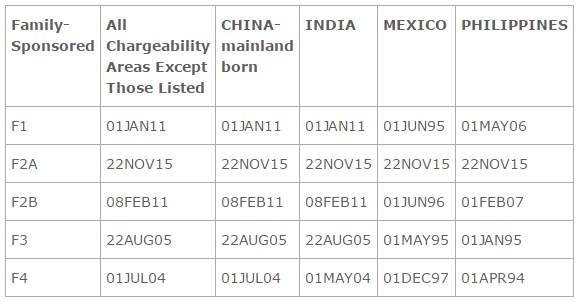The U.S. Department of State has released its February 2017 Visa Bulletin. Similar to previous months, the bulletin highlights some marked changes in priority dates. While these changes are slight, it is important to be aware of the correct dates for Final Action Dates and Dates for Filing.
February 2017 Visa Bulletin Dates
To better understand the rest of this post, here are the definitions of the types of dates referenced below.
Priority Date
A petition’s priority date is marked when it was properly filed with the USCIS. If a Labor Certification Application(LCA) was required for the visa, then the priority date is when the LCA was accepted.
Final Action Date
The Final Action Date (FA) is the date that a visa number will become active. If this date is current with your priority date, then a number will be available provided when you submit your application. Until October of 2016, submitting your application before the FA date would not yield a visa number.
Date for Filing Application
Since October 2016, a new date category has opened to help those who are stuck in the visa backlog. The Date for Filing a Visa Application (DF) becomes active when there are more visa numbers than there are petitions in a particular visa category.
When that happens, the USCIS will announce that the DF replaces the FA date so that more petitioners can submit their applications. However, your application will not be approved until your petition’s FA date.
Family-Sponsored Visa Category
View the full February 2017 Visa Bulletin released by the Department of State.
The first two preference categories for family-sponsored visas have seen the most change in their FA dates since last month.
In the first preference, F1, China, India, and the general chargeability category have moved forward by a month and two weeks to February 22, 2010. Mexico has gone forward two weeks to April 22, 1995. Finally, the date for the Philippines has moved forward two months to December 1, 2005.
The second preference is divided into two subcategories, F2A and F2B. For F2A, all chargeability areas except Mexico moved forward three weeks to April 15, 2015. Mexico moved forward three weeks to April 1, 2015.
Lastly, in the F2B preference category, the general chargeability category, India, and China have had their dates moved forward one month to July 8, 2010. The date for Mexico has moved three weeks to November 8, 1995. Finally, the Philippines have moved three weeks to April 8, 2006.
Family-Sponsored Visa Charts
The following charts for the February 2007 Visa Bulletin use a simple letter system to better understand the information. If a section is marked with a “C”, that means that the visa numbers are current and available to all applicants who are qualified.
If the section is marked with a “U”, then the numbers for this category are not authorized for issuance. When you see a section that has a date listed, the class is oversubscribed.
Final Action Dates

Dates For Filing
The February dates for filing family-sponsored applications are the same as last month’s bulletin.

Employment-Based Category Dates
In this section of the February 2017 Visa Bulletin, we’ll mainly focus on the differences in the first three preference categories for employment-based visas. For the first preference, the FA dates remain current just as they were in January.
In the second preference, however, one change takes place. The FA date for China moved forward one month to November 15, 2012. The dates for all other chargeability areas remain the same.
For the third preference, every chargeability area has a change in FA date. China’s date moved forward by three weeks to October 1, 2013. India moved forward one week to March 22, 2005. Mexico’s date is now October 1, 2016, moving two months forward. The Philippines moved ahead 3 months to October 15, 2011. The date for El Salvador, Guatemala, and Honduras moved forward 2 months to October 1, 2016. Finally, the dates for all other chargeability sections have gone forward 2 months to October 1, 2016.
Employment-Based Visa Charts
Final Action Dates

Recap of Changes to Employment-Based categories
EB-1: All chargeability areas are current. This includes China, Mexico, India, El Salvador, Guatemala, Honduras and the Philippines.
EB-2: All chargeability areas are current except China, which has a cut-off date of November 15, 2012, and India, which has a cut-off date of April 15, 2008.
EB-3: All of the chargeability areas for the EB-3 have cut-off dates. The date for the general section and Mexico is October 1, 2016. China is October 1, 2013. El Salvador, Guatemala, and Honduras is October 1, 2016. India is March 22, 2005 and the Philippines is October 15, 2011.
Employment-Based Visas – Dates of Filing
The February dates for filing applications for employment-based visas remain the same as last month’s bulletin.

Staying Up-To-Date
To stay up-to-date with the bulletins issued by the Department of State, be sure to subscribe to their monthly newsletter. To do this, just send an email with the message body “Subscribe Visa Bulletin” to [email protected].
You can also visit the USCIS website to learn if the DF dates are applicable this month.
How Our Immigration Lawyers Can Help
If you look at the above charts and see that your petition’s priority date is current, then you’re ready to move forward with the application process. To help ensure that this goes as smoothly as possible, it’s always a good idea to work alongside a qualified immigration attorney.
Our experienced immigration lawyers work tirelessly to help our clients attain legal permanent residency. To get in touch with one of our attorneys, you can fill out this contact form to schedule a consultation.
 Shilpa Malik
Shilpa Malik  Sabrina Saada
Sabrina Saada 